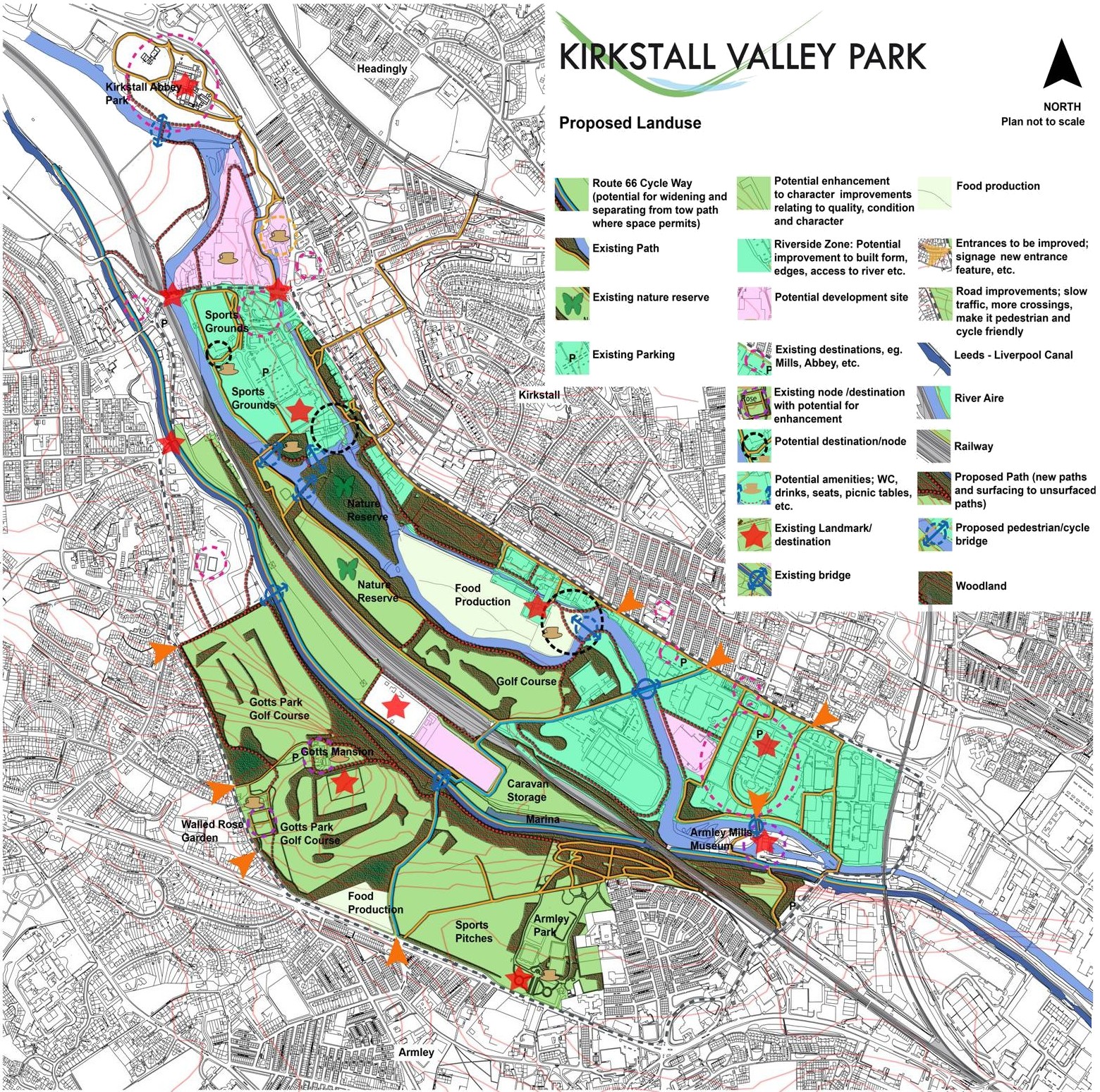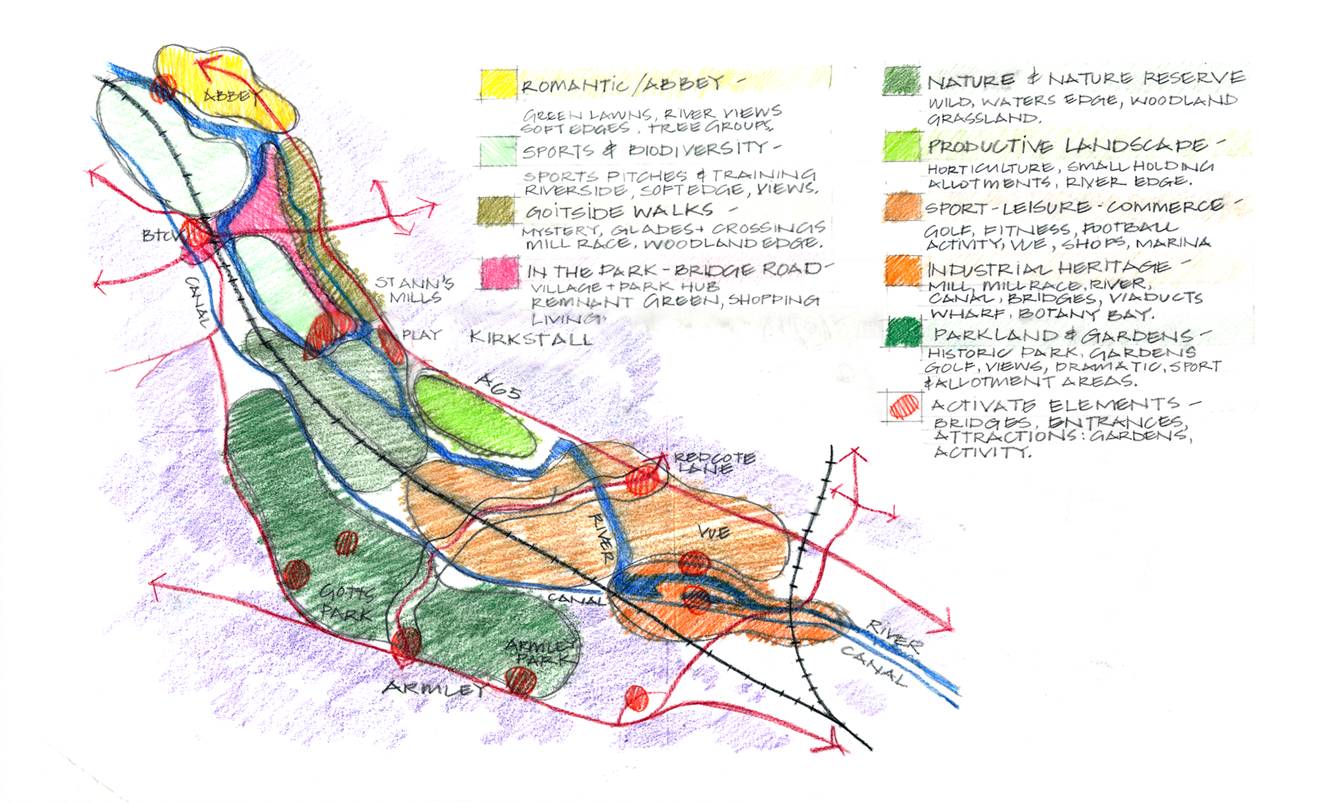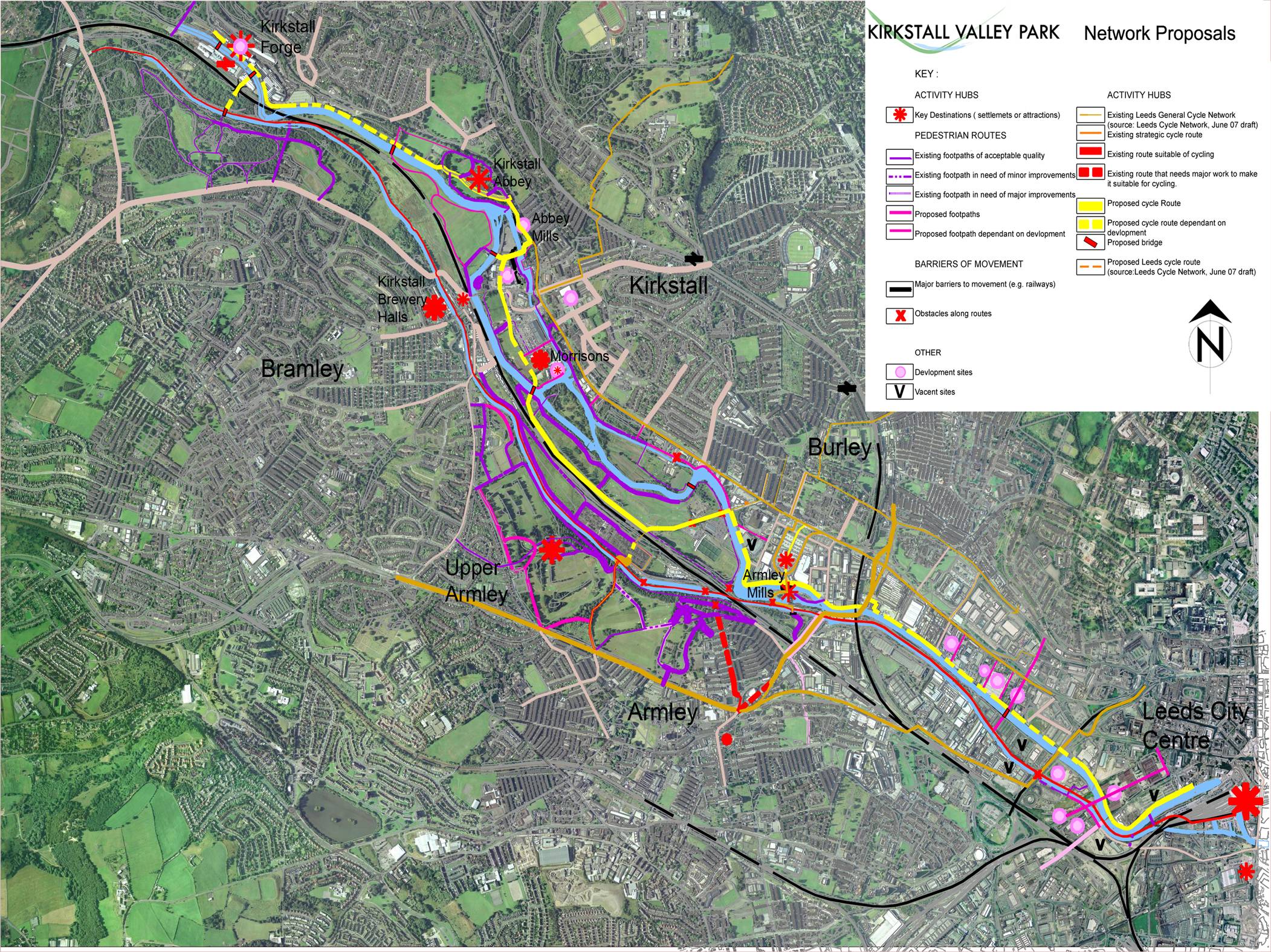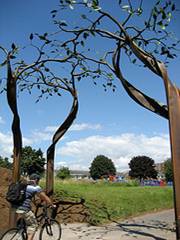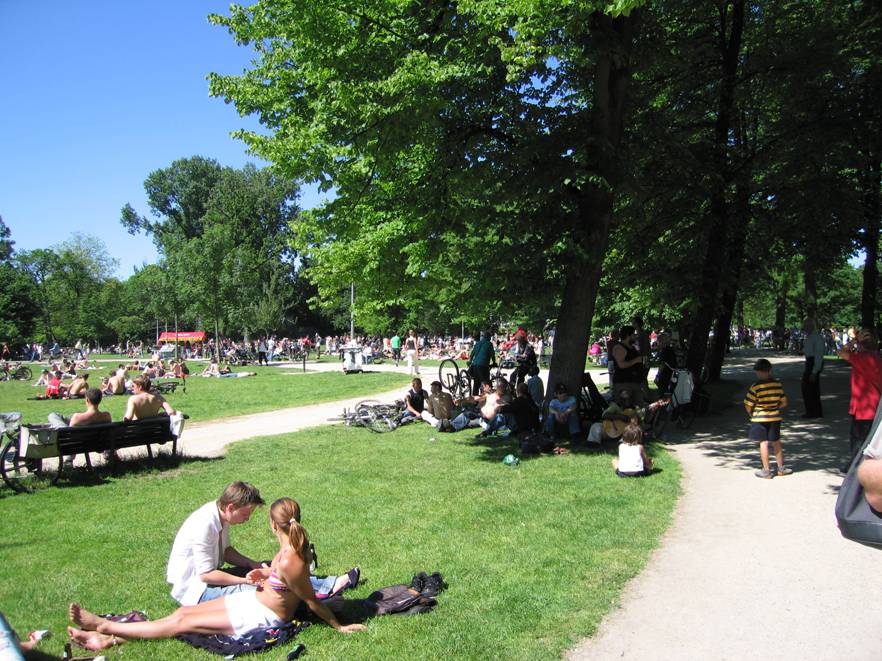INTRODUCTION
This study has been undertaken by DesignLeeds, the research and practice arm of The Leeds School of Architecture, Landscape and Design on behalf of Kirkstall Valley Park (KVP), a collaborative venture involving many organisations and community partnerships. Alongside Board members particular contributions by Sustrans, Groundwork, BTCV and Leeds Metropolitan University are acknowledged.
Kirkstall Valley Park is a not for profit company with charitable status that aims to establish a new public park in central Leeds. It forms part of the extensive West Leeds Country Park being established by Leeds City Council. Through partnership with local communities, the Council, educational providers and businesses the establishment of KVP will help realise the dreams of many people over the last thirty years in establishing this vital community resource, Kirkstall Valley Park.

The vision for KVP is the creation of a park which will form a Great Green Heart near the centre of Leeds which will help regeneration and provide accessible green space close to thousands of homes. A Great Network: Movement and Circulation is one section of the proposals illustrated above and is essential for the development of KVP. A Great Place covers Landscape and Built Form and A Great Partnership relates to Development and Community Partnerships.
A number of consultation events have taken place and informed the study. Draft proposals for KVP together with models and art work produced by local school children were exhibited at the Kirkstall Festival in July 2007 and a stakeholder workshop was organised in November 2007. These events were very well attended and generated much interest in KVP, confirming the significance of the proposals and the urgent need to implement them.
A Great Network for movement will have a fundamental impact on recreational opportunities, travel to work and on the health and well being of individuals and local communities. The proposal is to establish a great network of routes for walkers, cyclists and other park users. Routes will run east west along the valley, connecting the city with the countryside and provide cross valley connections into the surrounding communities.
The network will comprise major and minor routes which are organised to provide regional and local access as well as paths which connect to features of interest in the park and provide a variety of walks. The system will connect to other forms of transport, bus stops, car parks, railway stations and water bus stops. Irrespective of purpose, movement whether by car, bus, bike or walking should be concerned with experiencing places in an enjoyable and safe manner. Each journey can be unique and respond to the particular qualities and character of the locality and in this way give all year round value.
The network of pedestrian and cycle routes in KVP needs to be carefully designed and managed for commuting and leisure. Routes and connections, which link destinations should be safe, coherent, direct and attractive. They should be distinctive, and relate to the particular landscape that they pass through and they should create opportunities that encourage activity.
THE KIRKSTALL VALLEY
The Kirkstall Valley is one of Leeds’ best kept secrets. Very few people are aware of this substantial area of open space immediately adjacent to the city centre. The valley is sandwiched between Armley, Burley and Kirkstall, but physical barriers created by the Leeds -Skipton railway, the River Aire and the Leeds – Liverpool canal make it difficult to explore this part of the city. People either imagine that there is nothing there, or assume that the land was irretrievably damaged by its previous industrial heritage. Nothing could be further from the truth. The Kirkstall Valley is rich in nature and rich in cultural heritage and deserves to be enjoyed by the public to a much greater extent than is currently the case.

Gotts Park Armley
HISTORY AND LANDSCAPE CHARACTER
Local history can be traced from the foundation of Kirkstall Abbey in 1152. The monks were among the first to use the river. The weirs at Armley Mills and Kirkstall Abbey date from these times, but during the 18th and 19th centuries the valley became a major centre for the woollen industry, and a complex network of weirs and goits was constructed alongside mills, to supply additional energy. Many of these works survive to the present day including Armley, Burley, and St Ann’s Mills within the vicinity of the Park.
Armley Mills -once the world's biggest textile mill is now the home of Leeds Industrial Museum. It was once owned by Leeds Industrialist Benjamin Gott, who also commissioned Humphrey Repton to improve and enlarge a mansion nearby and lay out its extensive parkland. Gott's mansion overlooks the valley and its industrial features and together with the park was acquired by Wade's Charity and leased to Leeds City Council in 1928 in order to establish a public park which now includes a municipal golf course.
The Leeds Liverpool Canal was completed in 1816. In contrast to the River Aire, it has largely unpolluted water drawn from various Pennine catchments. This large body of clean, slow moving water is the home to various rare species of freshwater mollusc that resulted in its designation as a Site of Special Scientific Interest in 1984. The canal was once used to supply the power station with coal, and the former coal basin and loading bay have been converted into a narrow boat marina.

Gotts Mansion and Kirkstall Valley ca. 1853
The diverse landscape of the Kirkstall Valley which runs west from the centre of Leeds has a wide range of green spaces combined with a dramatic topography that affords many impressive views. The valley sides accommodate the urban villages of Kirkstall, Armley, Bramley and Burley and major water, rail and road routes run through the valley bottom. A remarkable range of landscape types can be found from woodland and extensive parkland, to small scale walled gardens and sports pitches. The island nature reserve and associated scrub land, contrasts with farmland and the open landscape of small grassy meadows. Open hill sides and incidental stands of trees provide a setting for foot paths, attractive glades and viewing points.
Despite these qualities there are many problems. The site is fragmented and there are barriers to movement. Much of the site is neglected and overgrown and although this can be an asset for wildlife it can feel unsafe and hostile for people. Paths and steps are often uneven and there are dangerous vestiges of previous industrial eras such as unprotected high river banks and rusty railings. Inappropriate signage and other crude details detract from the parkland experience. These aspects combined with a few intrusive developments cast a shadow over the otherwise rich and diverse environment.
A number of distinct character areas can be identified in the valley landscape and include particular features which provide a setting for the park proposals;
- Kirkstall Abbey Park and riverside
- Playing fields and grassland adjacent to the river
- Kirkstall Village
- Goit side walks and parkland
- Nature reserve and farmland
- Sports area and switching station
- Leeds Liverpool Canal and Armley Mills
- Cardigan fields leisure and commercial complex
- Gotts Park and Armley park
Response to the particularities of these areas is a key part of the Great Network. The outline proposals for the park illustrate a wide range of existing and potential destinations and activities that need to be connected in a variety of ways.
 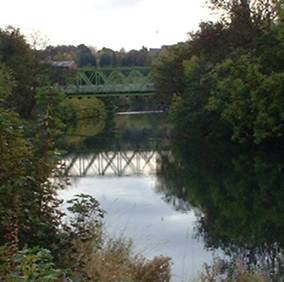
Electricity switching station River Aire: Redcote Bridge
POLICY CONTEXT
The policy context for the development of KVP and the Network underlines the significance of the proposals and covers the following key aspects;
Recognition by Leeds City Council in the 1950’s of the potential of Kirkstall Valley as public open space – commenced land acquisitions.
The inclusion of most of the area as playing fields and public open space in the 1972 Development Plan Review
Proposals for Kirkstall Valley Park in the 1980 Local Plan
Some inappropriate developments but also environmental improvements by Leeds Development Corporation in the 1990’s
2006 Government white paper – Strong and Prosperous Communities – stressing importance of community involvement
2007 The Core Strategy; Leeds Local Development Framework – includes aim of creating a well connected city with sustainable modes of transport
2005-2008 West Leeds District Partnership ‘Strategy for Success’ – identifies as one of its key priorities the development of the Aire Valley and Leeds Liverpool Canal as a green ‘linear link’.
West Leeds Country Park and Green Gateways launched in 2005 is an initiative by Leeds City Council with the intention of protecting, improving and publicising the recreational benefits of green space in West Leeds.
The draft Management Plan aims to secure:
- Suitable and sustainable greenspace
- Quality recreational areas
- Diverse wildlife habitats
- Strong community involvement
Relevant objectives include:
- The way marking of routes and sites of interest
- Improving key public rights of way
- Establishing a Green Gateways trail for walkers, horse riders and mountain bike riders
- Creating mini circular trails within the area
- Improving connections and access to new areas of greenspace
- Establishing new public rights of way or permissive ways
- Identifying conservation projects
The Leeds Waterfront Strategy published in 2002 by the Leeds Initiative is approved supplementary planning guidance to the Leeds Unitary Development Plan.
The study area covers 6.5km of the river and canal corridor through Leeds, from Thwaite Mills to Armley Mills. It’s identifies 3 zones, Armely Mills is within the western stretch of zone 1. Although the strategy only covers a small part of Kirkstall Valley Park its vision and aims are very similar:
The vision for the Waterfront Strategy is to 'Add vitality to the waterways and waterfront of Leeds through good planning and design.'
The objectives of the Strategy focus on:
- Improving pedestrian access and waterfront walkways
- Opportunities for environmental improvement
- Promoting the use of the waterways for leisure and navigation
- Conserving heritage and natural features
- Promoting sustainable development and coordinated design
- Distinctive coordinated design
- Accommodating diverse needs
Particular proposals of relevance to this study are:
- A network of primary and secondary routes is proposed, to link to City Centre, and access local communities. Direct as possible to facilitate easy and simple movement.
- Links to other forms of transport e.g. to the bus and railway stations and to car parks.
- The primary route is to be developed for dual use by pedestrians and cyclists. A cycling network is proposed.
- A water bus stop, and moorings are identified at Botany Bay, Armley.
- A focal point for water space activity and festivals is identified in Granary Wharfe, south of Leeds railway station.
- A primary route for pedestrians and cyclists is identified at Armley Mills on the Canal, linking to the Armley and Kirkstall neighbourhoods.
- A secondary route is identified along the riverside. With a waterside access point at the Vue leisure complex, Cardigan trading Estate, and Botany Bay.
The National Cycle Network and other Sustrans’ initiatives – Route 66 part of the Aire Valley Towpath Route runs alongside the Leeds Liverpool Canal through the park and many initiatives and campaigns such as ‘Safe Routes to Schools’ have a direct bearing on the proposed great network.
The Leeds Climate Change Strategy -Produced by Leeds Initiative the Strategy articulates a Climate Vision for Leeds and identifies as a key objective making walking and cycling more attractive.
ADJACENT COMMUNITIES AND NEW DEVELOPMENTS
The council wards and urban villages adjacent to KVP include Kirkstall, Burley, Bramley, Armley, Wortley, Headingley, Woodhouse, Holbeck and the City Centre covering a significant proportion of inner city and suburban Leeds. Shops, industry and public facilities such as schools exist within these districts together with two Universities and colleges in close proximity.
Some of these neighbouring areas suffer from significant traffic problems, economic disadvantage and a serious shortage of recreational open space. These handicaps are reflected in a wide range of socioeconomic indicators. For example school children in central Leeds face ten times the risk of a serious road accident when compared with their counterparts in the outer suburbs. Inner city children need safer places to play and safer access to schools and play facilities.
An improved network of movement and circulation will help to address a number of these issues and service existing and new developments in an appropriate way. Strong connections with existing and proposed cycle networks and footpaths are important such as links from residences to the universities.
New developments of particular significance to KVP include;
Kirkstall Forge where planning permission has been granted for a development which will accommodate 1385 new homes, in a variety of types sizes and styles as well as 16,518m2 of office space and social facilities. Conservation of the Forge (Grade II listed) is planned which will together with restaurants and a riverside hotel encourage visitors to the area.
The BHS/Alders site; a mixed use development which is in a crucial location relative to KVP and depending on the nature of site planning could enhance or detrimentally affect the character of the park and associated routes.
The refurbishment of Abbey Mills and St Ann's Mills which need to compliment and add to the qualities of KVP in a positive way. Changes to Mills should include orientation towards the park to make the most of increased activity.
Redevelopment of Kirkstall District Centre which will generate more journeys and further traffic congestion which would to an extent be ameliorated by the KVP network. Developments that create pedestrian friendly environments rather than car orientated solutions should be encouraged.
Mixed use developments between Kirkstall Viaduct and Leeds City Centre will have a major impact on KVP and increase the need for an effective network for movement and circulation. New development along the riverside will activate a new linear route and parkway.
THE PROPOSED PARK
The Park stretches from the Kirkstall Viaduct to Kirkstall Forge. It embraces the existing Armley, Gotts and Kirkstall Abbey Parks and overall it is over 200 hectares in extent.
A park in the Kirkstall Valley is not a new idea. Proposals were included in the Leeds City 1980 Local Plan and in a variety of ways attempts have been made to improve the area since that time. It is only recently that a not for profit company with charitable status has been formed with planning and design now taking place under the auspices of the KVP Board of Directors.
The aims of the Park are to:
- Create a green heart which conserves nature, enhances biodiversity and forms a naturalistic setting for healthy city living
- Provide access for all through the establishment of a network of routes through the park for cyclists and walkers to travel to work and enjoy for leisure and health
- Conserve and interpret the cultural legacy of the valley, such as Kirkstall Abbey, Armley Mills and other historic features through improved access and environmental improvement
- Create a place that encourages activities with things to see, things to do, opportunities for play and events to join in and watch
- Enhance destinations, features of interest and community facilities
- Improve connections through new routes, bridging points, entrances and links to the surrounding communities and new developments
- Encourage new developments that reflect the aims of the park and contribute to sustaining it and ensure that the positive impact of the park is realised in sensitive architecture and landscape design
The value of well designed green spaces as an integral part of urban regeneration is now widely recognized. In virtually every city worldwide initiatives are underway to improve former industrial sites and develop new environments for 21st century living. There are a number of notable examples of places where industrial heritage has provided a key aspect of new parks and where local communities have participated in the development and management of them. Kirkstall Valley Park is well placed to emulate these examples and contribute to sustainable city living.
| 






